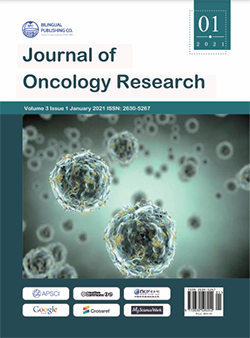Study of the Antitumor Activity of the Drug Dekoglitz on Two Tumors and Some Aspects of Its Mechanism of Action
DOI:
https://doi.org/10.30564/jor.v3i1.2756Abstract
Aim: Evaluation of the antitumor activity of the new drug Dekoglitz in animals with tumor strains of Sarcoma 45 in comparison with the drug dekocin, from which it was obtained, as well as with 5-fluorouracil and etoposide, and on ovarian tumors (OT) in comparison with the drug dekocin and identification of the effect of Dekoglitz on NA synthesis and internucleosomal DNA degradation. Methods: The study of preparations was carried out on 68 outbred rats with transplanted C-45 and OT tumors.The alkylating effect of the drugs was studied on cells tumor of Sarcoma 180. Results: The antitumor activity of dekoglitz on Sarcoma 45 was high, about 98/96%, with a remission rate of 80%. Its effect was 28-24% higher than that of dekocin. On OT, the effect of decoglitz with intraperitoneal administration reached 89/76% with a remission rate of 40%, with oral administration 96/86% with a remission rate of 60%. Conclusion:The study of the new drug Dekoglitz on animals with a tumor of Sarcoma 45 revealed its higher activity (by 20-27%) in comparison with the original Dekocin, 5-fluorouracil and etoposide with a lower level of side effects. On OT, the effect of Dekoglitz was 35-40% higher, especially after oral administration. Apparently, the great ability to suppress the synthesis of NA and carry out internucleosomal degradation and fragmentation of tumor DNA by the new drugs dekoglitz explains its antitumor efficacy,which is greater than that of Dekocin (K-18) in experiments on tumors.
Keywords:
Dekocin; Decoglitz; Animal tumors; DNA/RNAReferences
[1] Tolstikov. G.A., Baltika L.A., Shultz E.E., Pokrovsky A.G. Glycyrrhizic acid in Russian. J.Bioorganic Chemistry, 1997, 23(9): 691-709.
[2]
[3] Dalimov D.N., Gafurov M.B., Akhunov A.A.,Matchanov A.D., Vypova N.L., Khamidova G.R.,Nuritdinova N.S., Toshpulatov F., Esonov R. Supramolecular complexes of glycyrrhizic acid (structure,biological activity, application) in Russian. Scientific and practical conference “Uzbekistonda tabiy birikmalar kimyosining rivozhi va kelazhagi”. Tashkent,2016: 15-16.
[4]
[5] Dalimov D.N., Yuldashev H.A., Gafurov M.B., Vypova N.L., Inogamov U.K. Synthesis, structure and study of biological activity of supramolecular complexes of glycyrrhizic acid in Russian. Halgaro ylmium anzhuman, Tashkent, 2013: 17-18.
[6]
[7] Enikeeva Z.M., Ibragimov A.A. New class cytostatics with stimulation colony-forming units on a spleen (CFCs) in Russian. Tashkent, J. Fan va texnologiya,2016: 173.
[8]
[9] Holikov T.K., Gafur-Akhunov M.A., Goyibova S.,Enikeeva Z.M. New antitumor preparation decocin for the treatment of skin cancer, and igreasing effect of irradiation to the tumor as well. Journal AvicennaFreiburg - Germany, Heft 2, 2011: 32-37.
[10]
[11] Usmanov R.Kh., Rakhmatullaeva D.T., Enikeeva Z.M. Development of schemes for the use of a new domestic antitumor drug dekocin in the treatment of skin cancer of the eyelids and periorbital region in Russian. J. Med. Uzbekistan, 2011(6): 37-39.
[12]
[13] Guidelines for studying the antitumor activity of pharmacological substances. Compiled by E.M. Treschalin, O.S. Zhukova, G.K. Gerasimova, N.V.Andronova, A.M. Garin in the book. Guidelines for experimental (preclinical) study of new pharmacological substances in Russian. Ed. R.U. Khabrieva.Moscow, 2005: 637-682.
[14]
[15] Samusenko A.V. Mechanisms of cell death under the action of olivomycin and its derivatives in Russian.Author’s abstract, Ph.D., Moscow-2009: 19.
[16]
[17] Maniatis T., Fritsch E. E., Sambrook J. In the Book:Molecular Cloning. A Laboratory Manual. Cold Spring Harbor Laboratory, 192: 480.
[18]
[19] Enikeeva Z.M., Kholturaeva N.R., Agzamova N.A.New complexes of GK and MASGK with colchicine derivatives in Russian. Thesis of the conference“Medicines based on natural compounds”Tashkent,2018: 193
Downloads
How to Cite
Issue
Article Type
License
Copyright and Licensing
The authors shall retain the copyright of their work but allow the Publisher to publish, copy, distribute, and convey the work.
Journal of Oncology Research publishes accepted manuscripts under Creative Commons Attribution-NonCommercial 4.0 International License (CC BY-NC 4.0). Authors who submit their papers for publication by Journal of Oncology Research agree to have the CC BY-NC 4.0 license applied to their work, and that anyone is allowed to reuse the article or part of it free of charge for non-commercial use. As long as you follow the license terms and original source is properly cited, anyone may copy, redistribute the material in any medium or format, remix, transform, and build upon the material.
License Policy for Reuse of Third-Party Materials
If a manuscript submitted to the journal contains the materials which are held in copyright by a third-party, authors are responsible for obtaining permissions from the copyright holder to reuse or republish any previously published figures, illustrations, charts, tables, photographs, and text excerpts, etc. When submitting a manuscript, official written proof of permission must be provided and clearly stated in the cover letter.
The editorial office of the journal has the right to reject/retract articles that reuse third-party materials without permission.
Journal Policies on Data Sharing
We encourage authors to share articles published in our journal to other data platforms, but only if it is noted that it has been published in this journal.




 Aims and Scope
Aims and Scope Zulfiya M. Enikeeva
Zulfiya M. Enikeeva

